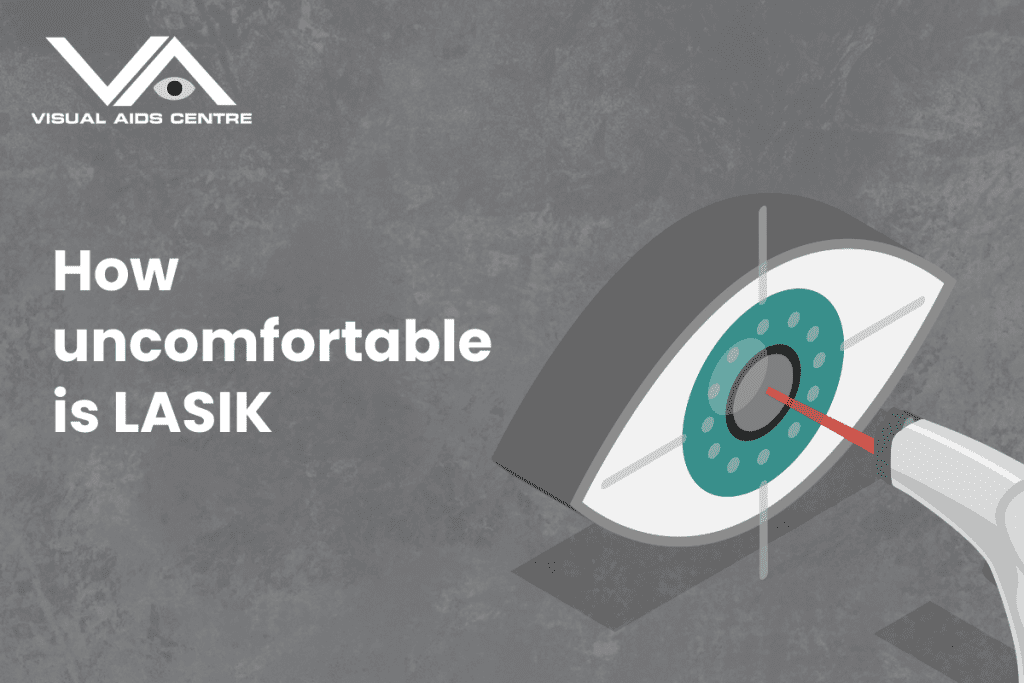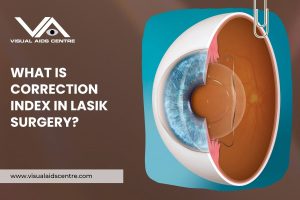Table of Contents
ToggleLASIK is generally not an uncomfortable procedure, thanks to advancements in technology and the use of numbing eye drops.
Most patients report experiencing only mild sensations during and after the surgery. However, like any medical procedure, it is essential to understand every aspect of LASIK to have realistic expectations about comfort levels.
If you are considering LASIK to correct vision problems like nearsightedness, farsightedness, or astigmatism, you likely have concerns about how it will feel during and after the surgery. This in-depth guide provides a detailed explanation of what to expect in terms of comfort before, during, and after LASIK.

What to Expect When You Prepare for LASIK?
Before the actual surgery, your surgeon will perform thorough pre-operative tests and assessments to ensure you are a good candidate for LASIK. These are non-invasive and designed to measure the structure of your eyes, your prescription, and your overall eye health.
Pre-Surgery Discomfort
The preparation phase for LASIK typically includes dilating your eyes using special drops, which helps the doctor better examine the interior structures of your eyes. Some people find dilation slightly uncomfortable, as it can cause sensitivity to light and blurry vision for a few hours. Rest assured, this is temporary and usually subsides within 4-6 hours.
Your doctor may also recommend avoiding wearing contact lenses several days or weeks before the procedure. Switching to glasses might feel inconvenient but is important to ensure accurate test results.
Anxiety and Nervousness
It’s natural to feel a bit anxious before undergoing eye surgery. Many patients worried about LASIK express psychological discomfort rather than physical unease. Keep in mind that the surgery is quick, typically completed in less than 30 minutes for both eyes. Talking to your surgeon about your concerns can help ease your fears.
During the Procedure
The actual LASIK procedure is known for being remarkably swift and nearly painless. Here’s what happens during the surgery and how it feels:
Step 1: Application of Numbing Drops
To maximise your comfort, your surgeon will apply anaesthetic eye drops before the procedure begins. These drops numb the surface of the eye, ensuring you don’t feel pain during the process. Within seconds, your eyes will be numb, eliminating the sensation of pressure or discomfort.
Step 2: Use of the Speculum
To hold your eyelids open, a small device called a speculum is used. While this might feel unusual or slightly awkward, there is no pain involved. Some patients describe it as a mild sensation of resistance.
Step 3: Creating the Flap
A thin flap is created in the cornea, either with a microkeratome (a precision blade) or a femtosecond laser. During this phase, you may feel some gentle pressure on your eye. Patients often compare it to the feeling of pushing against a closed eyelid with a finger—not painful, but noticeable.
Step 4: The Laser Correction
Once the flap is created and lifted, the excimer laser reshapes the cornea to correct your vision. At this stage, most patients feel no discomfort because the eye is still under the effect of numbing drops. You’ll be asked to focus on a target light, and the laser will perform its work within seconds.
Step 5: Repositioning the Flap
Finally, the doctor repositions the corneal flap back into place. It adheres naturally without stitches. Again, this is a painless process.
Overall procedure discomfort rating (on a scale of 1 to 10): 1-2. It’s more about unusual sensations than actual pain.
After the LASIK Procedure
While LASIK is virtually painless during the procedure, some mild discomfort may appear as the numbing effect wears off. Here’s how it feels post-surgery:
First Few Hours
The first few hours after LASIK are typically the most uncomfortable period. Common sensations include:
- Dryness: Your eyes may feel dry, gritty, or itchy, similar to the sensation of having an eyelash in your eye.
- Burning or Stinging: Some patients report a slight burning or stinging sensation, which is completely normal.
- Watery Eyes: Your eyes may tear up as they adjust.
- Sensitivity to Light: Bright light can feel harsh, so it’s a good idea to wear sunglasses during this period.
Your doctor will usually recommend resting your eyes by keeping them closed for a few hours after the surgery. Most patients find significant relief after sleeping or lying in a dark room, as the eyes need time to heal.
24 to 48 Hours Afterwards
By the next day, most of the initial discomfort has subsided. You may still experience:
- Mild dryness that can be alleviated with lubricating eye drops recommended by your doctor.
- Halos or Glare around lights, especially at night. This typically improves over the following weeks.
- Occasional Sharp Sensations as your eyes heal, but these are usually brief and infrequent.
Your first post-operative visit will occur within 24–48 hours, during which your doctor will review your progress and ensure everything is healing properly.
Long-Term Comfort
For most individuals, discomfort is minimal and improves rapidly. By the one-week mark, the majority of patients feel completely normal and enjoy notably better vision. Residual dryness may persist for a few months but is generally manageable with medicated or over-the-counter eye drops.
Tips to Minimise Discomfort
- Follow Post-Operative Instructions: Stick to the guidelines provided by your surgeon, including the use of prescribed medications like anti-inflammatory or antibiotic eye drops.
- Rest Your Eyes: Avoid screens, strenuous activities, and anything that may strain or expose your eyes to direct light.
- Use Artificial Tears: If dryness persists, lubricating eye drops can make a significant difference.
- Wear Protective Eyewear: Use the provided shield or goggles to prevent accidentally rubbing your eyes post-surgery.
- Avoid Physical Contact: Protect your eyes from dust, smoke, and water (no swimming or hot tubs) as they heal.
Understanding Your Tolerance for Discomfort
It’s important to note that pain tolerance and sensitivity vary from person to person. For example:
- Some patients feel only minor dryness and continue with their routines effortlessly.
- Others may find halos or glare mildly distracting for a few weeks post-surgery.
- Still, others might not notice much discomfort at all.
Communicating with your surgeon is key to setting expectations and addressing any specific concerns you may have.
Final Thoughts on LASIK Discomfort
The thought of eye surgery may initially sound daunting, but most LASIK patients agree that the process is far less uncomfortable than anticipated. With numbing drops, advanced laser technology, and modern aftercare solutions, LASIK has become a remarkably comfortable procedure for a vast majority of individuals.
For many, the brief and mild sensations experienced during LASIK are well worth the life-changing results of improved vision. Imagine waking up to clear sight without reaching for glasses or contacts—this benefit outweighs temporary discomfort for most patients.
Whether you’re thinking about LASIK for its convenience or freedom from corrective lenses, understanding what to expect during the process is the first step toward making an informed decision. If you’re still unsure, consult with an experienced LASIK specialist to determine whether it’s the right choice for you.













